Dear readers
New Year has come and gone, and like everyone else in Denmark we also have a new year’s resolution in the capsule group: We must build a good and useful full size model of the capsule.
As with so many other New Years resolutions we started out full steam ahead last weekend. We produced the first pieces of what will become a boiler plate model in steel. You can read more about it in this blog.
The first iteration of the capsule model has two purposes: The first is to experiment with how the astronaut will be positioned in the capsule. Before Christmas we held a meeting in the capsule group. Our own “Space Historian” Carsten Olsen gave us a lecture on the history of astronauts from the earliest space missions (Gemini, Mercury) to the current (Soyuz) and to the future (Blue Origin, Dragon, Space X). We learned how the different missions have solved the challenges of getting an astronaut safely into space and back to earth (or the ocean as it was on US missions).
Once we’ve placed the astronaut, we can investigate what will be the best location for the hatch, as well as the location and size of “windows”. This gives us a good starting point for the next iteration, where we will look into the right materials and manufacturing processes.
The other primary purpose is to provide a PR platform, which will give us the opportunity to show the public what we’re working towards. Now that we will have something that is the right size, we might as well paint it and make it look “real”.
In addition to the two primary purposes, there are several other purposes which we will look at if and when they are relevant. It could, for example, be drop tests in water (a bit like we did with Tycho Deep Space), or to test different stabilization systems or something completely else.
Spica (and thus the capsule) will as mentioned in previous blogs, be 955 mm in diameter. When we were to make the cylindrical part of the capsule, we started with a 1500 x 3000 x 2 mm piece of steel plate, which we rolled in our old faithful roller (which happened to be just over 1500 mm wide). It turns out that the circumference of a circle with a diameter of 955 mm is by coincidence 3000 mm. One would almost think that it was on purpose… In fact, it turned out that the plate stretched a little more than 10 mm when it was rolled so the diameter ended up closer to 960 mm, but we thought it was a good first attempt.
A shortcoming of our roller is that it has only three rolls. This means that it can’t make the plate round all the way to the end. There is a piece of approx. 100 mm that remains straight. It gave us some challenges when we formed the plate into a tube. We made a series of point welds down the side which would become the long seam weld. It gave us the possibility to roll a little further towards the edge. We didn’t get it all the way, but we got a tube that is very close to cylindrical.
To stiffen the tube a bit, we also rolled two rings (from a 15 x 30 x 1.5 mm steel profile) which will be welded into the pipe, and four pieces of the same steel profile are also welded between the two rings. It gives us an inner frame that stabilizes the thin-walled tube.
At the same time, we welded an end cap to the bottom of the capsule and a flange which can be used to mount a possible deformation zone. We will delay welding the top part on until we’ve made the hole for the hatch. Otherwise it will undeniably be rather difficult to get in and out of the capsule …
Now we need to build a frame for the capsule to stabilize it when we crawl into it.
Stay tuned.
Ad astra Martin H. Petersen, CS Capsule lead
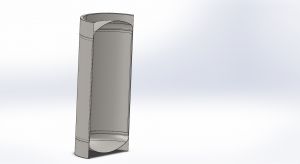
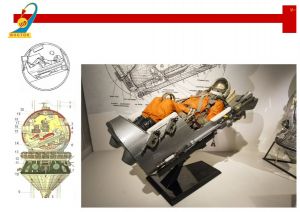
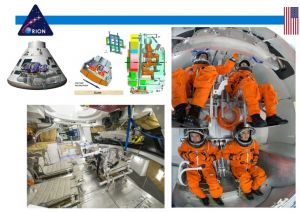

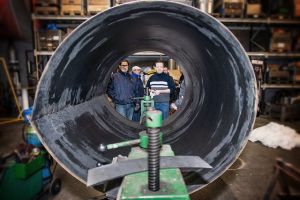
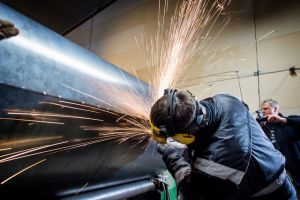
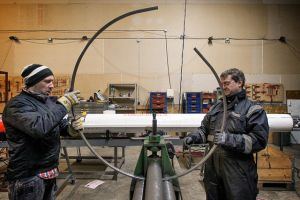
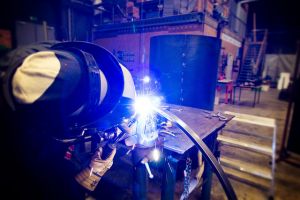
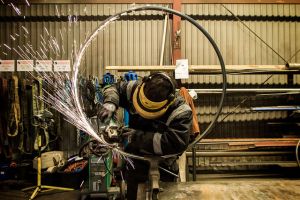
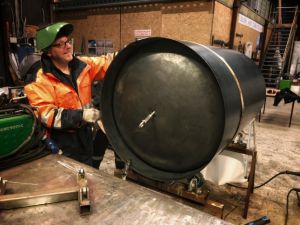




6 Comments
jose fernandp ballen · 22nd January 2018 at 5:02 pm
Excelente, y en hiora buena!!, les felicito de verdad. Publico cada uno de sus progreso en mis paginas y ya hay muchos aficionados en Colombia, interesados en su trabajo, todos esperamos el dia del lanzamiento de un piloto al espacio ppor parte de copenhagensuborbitals, sera un dia inolvidable.
Saludos desde Colombia, y animo!!
Ned Goldreyer · 27th January 2018 at 12:15 am
I am a HUGE fan of you and your endeavor and have been since the beginning of the project. I wonder if you would mind answering just a few questions?
1. How are you planning to pressure test the capsule?
2. What is the launch weight?
3. Would it be rated for orbital flight?
4. Would it be compatible with other launchers, such as Rocket Labs’ Electron or the Firefly Aerospace Alpha?
5. After initial test runs, what do you estimate it might it cost to purchase?
Mikkel Højbak · 31st January 2018 at 8:47 am
@Ned Goldreyer
Not a CS member here, but I think I can help answer some of the questions.
1. They won’t pressure test the capsule, I assume. They have a space suit to keep pressure where they need it.
2. The launch weight of the final Spica mission I don’t think they have a solid estimate for yet,, but the upcoming Nexø II mission is 292 kg at launch. ( https://copenhagensuborbitals.com/missions/nexo-ii/ )
3. The requirements for orbital flight are pretty much the same as those for suborbital. The rocket itself will not have the capacity to bring enough fuel to go orbital though, so they would need to design a new and bigger one if that is the goal.
4. They are making their own stuff. No reason to bother with compatibility if you have no plans to use it – I would not be surprised if using someone else’s launch platform costs as much as the rest of the mission does. The commercial space agencies have quite different budgets to operate on.
5. This one I’ll have to pass on.
Thomas Pedersen · 4th February 2018 at 11:06 pm
We are happy hear that Ned 🙂 As for the questions:
1) We will put it though several pressure cycles (over pressure) to validate that it can withstand the low pressure (vacuum) at 100 km altitude without leaking.
2) Spica launch weight is about 3200 kg. Of which around 350 kg is the capsule.
3) I am afraid not. The onboard life support will be limited to only a few hours. It will only carry batteries (no solar panels) for electric power and it has no way to de-orbit itself. Also, it does not have a heat shield strong enough for returning from orbit. The total energy in the system is vastly greater from orbit than from 100 km suborbit.
4) Possibly, but it is not something we are looking into at all.
5) I don’t think it will be for sale 🙂 We have a small (but growing) internal museum. The curator is very anxious to get his hands on new hardware, so once it has served its purpose it will retire to our museum.
Igor · 18th February 2018 at 11:29 am
Get out of this capsule, without help, easily?
Kasey · 2nd April 2018 at 9:48 pm
I was wondering three things
1. How will you abort in the event of a failure
2. What kind of heat shielding will you use
3. How will you direct said heat shield in the right direction.
Comments are closed.